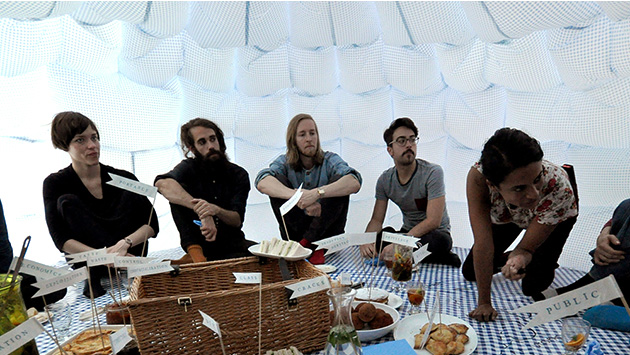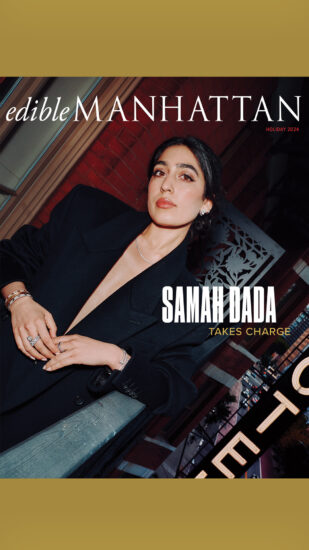Recently, in a room of a gallery inside Manhattan’s AC Institute, visitors would have been surprised to find a giant inflatable tent. Covered in red and white checkers, the tent looks like a picnic-themed bouncy house more than the site of a discussion about food and society. Yet the latter is exactly what curious visitors who crawl inside will find.
During a special event on Saturday, May 23, a rotating picnic of seven to ten people sat on the tent floor, framing a smorgasbord of foods with some origin involving New York City. There were drinks like egg creams and celery sodas and foods ranging from cheesecakes and pickles to pizza and hot dogs. While at first the spread seemed random, the artist behind the project led a discussion of how each one fit into the foodscape of the city.
This New York tent was part of a series called Temporary Places, Edible Spaces by the Australian artist Keg de Souza. The first of these tents was in a London gallery, then Scotland and Vancouver, each one exploring how the local culture shaped the foods that are still eaten by residents today. But this is no powerpoint presentation. Though de Souza researches foods ahead of time in order to prepare or purchase them for discussions, the information is crowdsourced. She may introduce a food and its relevance within the city but from there the guests add their own experience and knowledge. As de Souza says, “I lead the discussion but I don’t control it.”
She chose the picnic format because she wanted something that felt casual and nonhierarchical. (A formal dinner with de Souza sitting at the head of the table, for instance, would have had a different effect.) She’s found that people’s natural inclination to snack at a picnic has led to snacking with the conversations too, and in a good way. “No one feels pressured to say anything meant to be really important,” de Souza says. Instead, everyone shares their opinions and personal experiences with food.
de Souza tells the picnic that Dr. Brown’s Cel-Ray Soda, for example, was first made in Brooklyn in 1868. Then one guest whose family has lived in New York for generations reveals that the soda “used to be called Jewish champagne” and was originally marketed as a “tonic” until the FDA stopped them from using the term. Another person mentions that it reminds him of Moxie, a bittersweet soda from Maine with a similarly odd taste.
While this is fascinating stuff to anyone with an interest in New York history or food, there is a reason why the talk takes place in a gallery: it’s art too. During the event, de Souza moves over the tent floor, drawing a map in permanent marker of the discussion itself. The talk about knishes has dotted lines leading to tangents about its similarity to other foods like empanadas, samosas, or Cornish pasties, and to one about portable foods, and about potatoes, and about the knish’s Jewish origins. Even when the guests meander out of the tent and the food gets removed or eaten, these maps remain. de Souza says, “It’s a way of me coming in as an outsider, gathering this knowledge and presenting it back to [local residents].” Each map becomes part of a small publication that includes pieces of the maps as well as reflections on some of the topics discussed. Once the discussion is over, de Souza says that the map “alludes to what has happened but doesn’t give the whole conversation.” Instead, newcomers are presented with a puzzle of sorts that they have to try to piece together.
It’s curious to think of how someone who wasn’t at the event might interpret parts of the map, phrases like “Walmart regulated out,” or “1st visit to NY bought from street cart,” which are like ghosts of conversations past. The dotted lines connecting them to each other look like cartoon trails of picnic ants marching past.
Featured photo courtesy of AC Institute



